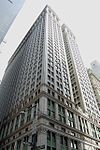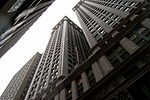23 Wall Street (also known as the J.P. Morgan & Co. Building) is an office building in the Financial District of Manhattan in New York City, at the southeast corner of Wall Street and Broad Street. Trowbridge & Livingston designed the four-story building in the neoclassical style. Constructed between 1913 and 1914, it was originally the headquarters of J.P. Morgan & Co. Since the late 2000s, it has been in a state of disuse.
The building contains an astylar exterior, with plain limestone walls pierced by unadorned windows in deep reveals. The ground story is rendered as a single high piano nobile over a low basement; above it are a second story, a main cornice, and two additional stories. After its completion, the building became known as the headquarters of J.P. Morgan & Co.—the "House of Morgan"—although its exterior was never signed with the Morgan name. The banking room, which took up nearly the entire ground floor, contained offices and was used for banking transactions. This space contained a coffered ceiling with a dome and, later, a large crystal chandelier. Mechanical equipment and vaults were in the basement, with executive offices and employee facilities on the upper floors.
23 Wall Street replaced the Drexel Building, which was the banking headquarters for J.P. Morgan & Co. predecessor Drexel, Morgan & Co. The Wall Street bombing in 1920 damaged it, however, J.P. Morgan & Co. did not remove the shrapnel marks in defiance to the bombing's perpetrators. In 1957, the building was linked to neighboring 15 Broad Street, and the two buildings served as the J.P. Morgan & Co. headquarters until 1988. During the 2000s, there were plans to convert both 23 Wall Street and 15 Broad Street into a condominium complex. 23 Wall Street was sold in 2008 to interests associated with the billionaire industrialist Sam Pa but remained largely empty afterward.
Depicted in numerous media works, 23 Wall Street's simple design was largely praised upon its completion. The building was designated a city landmark by the New York City Landmarks Preservation Commission in 1966 and added to the National Register of Historic Places (NRHP) in 1972. It is a contributing property to the Wall Street Historic District, a NRHP district created in 2007.











